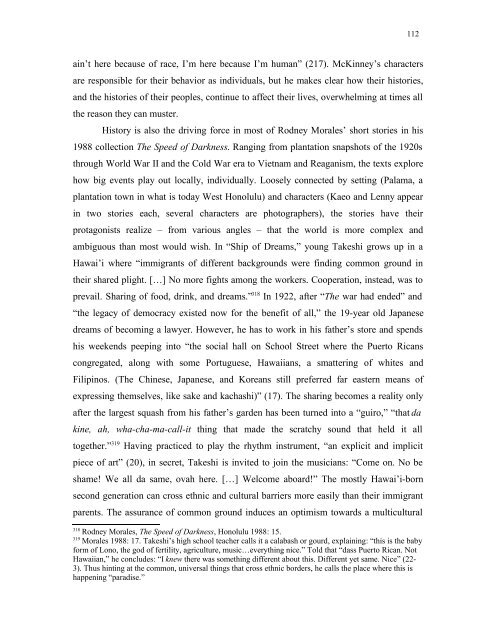A Paradise Lost - KOPS - Universität Konstanz
A Paradise Lost - KOPS - Universität Konstanz
A Paradise Lost - KOPS - Universität Konstanz
You also want an ePaper? Increase the reach of your titles
YUMPU automatically turns print PDFs into web optimized ePapers that Google loves.
ain’t here because of race, I’m here because I’m human” (217). McKinney’s characters<br />
are responsible for their behavior as individuals, but he makes clear how their histories,<br />
and the histories of their peoples, continue to affect their lives, overwhelming at times all<br />
the reason they can muster.<br />
History is also the driving force in most of Rodney Morales’ short stories in his<br />
1988 collection The Speed of Darkness. Ranging from plantation snapshots of the 1920s<br />
through World War II and the Cold War era to Vietnam and Reaganism, the texts explore<br />
how big events play out locally, individually. Loosely connected by setting (Palama, a<br />
plantation town in what is today West Honolulu) and characters (Kaeo and Lenny appear<br />
in two stories each, several characters are photographers), the stories have their<br />
protagonists realize – from various angles – that the world is more complex and<br />
ambiguous than most would wish. In “Ship of Dreams,” young Takeshi grows up in a<br />
Hawai’i where “immigrants of different backgrounds were finding common ground in<br />
their shared plight. […] No more fights among the workers. Cooperation, instead, was to<br />
prevail. Sharing of food, drink, and dreams.” 318 In 1922, after “The war had ended” and<br />
“the legacy of democracy existed now for the benefit of all,” the 19-year old Japanese<br />
dreams of becoming a lawyer. However, he has to work in his father’s store and spends<br />
his weekends peeping into “the social hall on School Street where the Puerto Ricans<br />
congregated, along with some Portuguese, Hawaiians, a smattering of whites and<br />
Filipinos. (The Chinese, Japanese, and Koreans still preferred far eastern means of<br />
expressing themselves, like sake and kachashi)” (17). The sharing becomes a reality only<br />
after the largest squash from his father’s garden has been turned into a “guiro,” “that da<br />
kine, ah, wha-cha-ma-call-it thing that made the scratchy sound that held it all<br />
together.” 319 Having practiced to play the rhythm instrument, “an explicit and implicit<br />
piece of art” (20), in secret, Takeshi is invited to join the musicians: “Come on. No be<br />
shame! We all da same, ovah here. […] Welcome aboard!” The mostly Hawai’i-born<br />
second generation can cross ethnic and cultural barriers more easily than their immigrant<br />
parents. The assurance of common ground induces an optimism towards a multicultural<br />
318 Rodney Morales, The Speed of Darkness, Honolulu 1988: 15.<br />
319 Morales 1988: 17. Takeshi’s high school teacher calls it a calabash or gourd, explaining: “this is the baby<br />
form of Lono, the god of fertility, agriculture, music…everything nice.” Told that “dass Puerto Rican. Not<br />
Hawaiian,” he concludes: “I knew there was something different about this. Different yet same. Nice” (22-<br />
3). Thus hinting at the common, universal things that cross ethnic borders, he calls the place where this is<br />
happening “paradise.”<br />
112

















